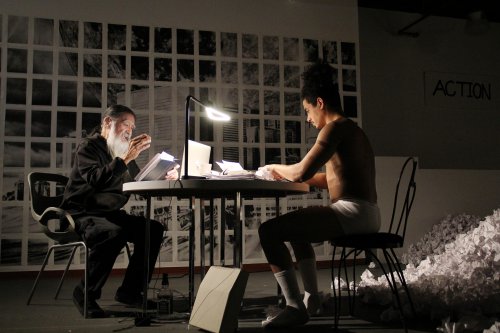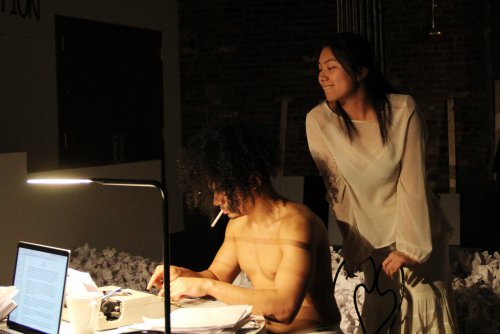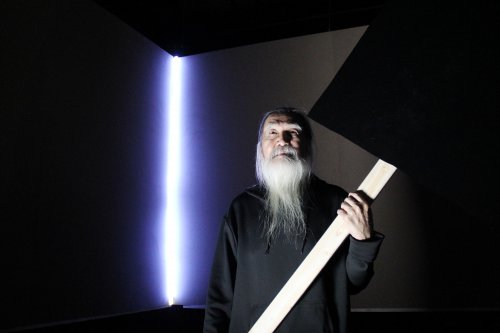Hi-Fi | Wi-Fi | Sci-Fi: Predictions Past Present and Future
Attempt to make five one acts from Robert Patrick into a multimedia high-tech evening proves to be dated and flat.

Agosto Machado and John Guttierez in a scene from Robert Patrick’s “Hi-Fi | Wi-Fi | Sci-Fi” (Photo credit: Minji Lee)
[avatar user=”Victor Gluck” size=”96″ align=”left” ] Victor Gluck, Editor-in-Chief[/avatar]Playwright Robert Patrick has been known for writing one act plays since the late 1960’s in which he foreshadowed the technological world we live in. Hi-Fi / Wi-Fi / Sci-Fi: Predictions Past Present and Future, presented by La Mama’s Culture Hub in association with the Seoul Institute for the Arts, is an attempt to turn five Patrick one acts which stretch from the 1966 Action to a brand new play, Anything Is Plausible, into a multimedia high-tech evening. Unfortunately, the production co-directed by Billy Clark and Jason Trucco (who also designed the sets) is so low tech as to make the plays seem dated and flat. The average person is so used to the latest advancements in smart phones, computers and the Internet that the five plays seem to be caught in a time warp. All of the plays have interesting premises which fail to develop beyond the initial conceits.
The plays are presented in three venues in La Mama’s new performance space called The Downstairs and audience members are ushered from one to the other for the different plays. For all except the last ten minute play, the audience stands to watch the performances. The first play, Action, finds two men, an older man played by Agosto Machado and a younger man (John Guttierez), writing at the same table opposite but oblivious of the other. Each one is narrating a story of the other one. The women in their lives (played by Yeena Sung and Valois Mickens) enter briefly and interact with them.
While the young man (dressed only in his underpants) writes on a manual typewriter, the older man writes on an iPad. Whether one is the other at a different age is never made clear. While the set is elaborate, most of the audience cannot see whether Machado is reading from a text or writing one so that the premise of the two men mirroring each other is lost. Guttierez arrives in an unusual way but nothing special is made of this unique entrance.

John Gutierrez and Yeena Sung in a scene from Robert Patrick’s “Hi-Fi | Wi-Fi | Sci-Fi” (Photo credit: Minji Lee)
The next three plays all take place in the second venue in which the audience is entirely surrounded by screens on all sides. In Camera Obscura (1968), probably Patrick’s most famous one act, a couple who have been in contact but have never met attempt to communicate with each other via some kind of telecommunication hook. The ground rules are that they have only five minutes and that there is a five second delay in the transmission which makes responding difficult.
In this revival, the man and woman, played by Gutierrez and Sung, are observed off stage in opposite corners of the playing space being videotaped, while the audience watches their transmissions on opposite screens. The play has been alternately described as a commuter-matched couple meeting by long distance hook up or two people trying to reach each other from different planets. Here there feels like something sinister is going on as if the delay and the time limit are a disruption of normal discourse or that the couple might be in prison and only given this time to talk.
In the same venue, the 1981 All in the Mind, a science fiction play set three generations into the future, follows. It is the world in which all people can communicate by telepathy and all are one mind. Aside from the obvious advantages (no secrets, all knowledge is shared, etc.,) there is a downside. Religion, politics and poetry have come to dominate, aside from the fact that no dissent or subversion will be tolerated. While they tell a new born baby in Tunisia what has happened in the world, they put up black and white abstract drawings (designed by Mickens) all around the space on the screens while the audience listens to them on tape as though listening in to their minds. Near the end an action (not in the script but added by the directors) suggests that they are living in a totalitarian world. As Machado and Mickens go about their tasks like automatons, there is no emotion in their performances.

Agosto Machado in a scene from Robert Patrick’s “Hi-Fi | Wi-Fi | Sci-Fi” (Photo credit: Minji Lee)
Simultaneous Transmissions (1973) had the potential to be the most powerful of the plays. Two families from opposing sides (seen on screen) warn their sons to beware of the others. Eventually, the sons are commanded to take action against the enemy other which ends ironically. As the cast is only made up of Machado, Valois and Gutierrez, and as it was only possible to watch and listen to one screen at a time, the threat is diminished and the play confusing.
The new play, Anything Is Plausible, being given its world premiere, is set at the Super State Cultural Conference in 2117, a world in which simulated three-dimensional or live performance is possible on television sets. We are offered a chance to see All in the Mind again but this time played with a different cast that has been digitally created. However, as the play uses no technology and the host played by Harold Lehmann simply appears before us on mike the idea is completely lost by the staging.
The only real high-tech exchanges take place only three times during the run of the show. At the performances of February 6, 9 and 17, one of the roles in Camera Obscura will be performed telematically from Seoul Institute for the Arts in Korea and directed by Il Kyu Park. Hi-Fi/ Wi-Fi/ Sci-Fi which uses a great many sound specialists for little effect is an interesting idea but doesn’t go far enough either dramatically or in terms of modern technology to have much impact. As a cautionary tale, time has caught up with these plays and passed them by.
Hi-Fi / Wi-Fi / Sci-Fi (though February 19, 2017)
The Downstairs, La Mama, 66 E. 4th Street, in Manhattan
For tickets, call 212-352-3101 or visit http://www.lamama.org
Running time: one hour and 15 minutes






Leave a comment